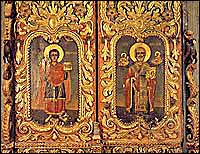 However it was the arts and crafts, wood-carving and icon
painting that brought about the unfading glory of Tryavna and turned into
a two-century major livelihood for the local population.
However it was the arts and crafts, wood-carving and icon
painting that brought about the unfading glory of Tryavna and turned into
a two-century major livelihood for the local population.Bright and enlightened men lived in Tryavna who contributed enormously to the cultural and economic progress of the settlement. Land was both scarce and barren, and this happened to be the main prerequisite for the rapid development of crafts. Traditional crafts as goldsmith's trade, raw silk processing intended for decorating purposes, braid-making, fleecy-rug weaving, silk-worm breeding, cart-making, rose oil and packsaddle manufacture, coppersmith's trade met the basic needs of the local inhabitants. A considerable part of the manufactured goods reached as far as Istanbul, Beirut, Edirne, Moscow, Odessa, etc.
 However it was the arts and crafts, wood-carving and icon
painting that brought about the unfading glory of Tryavna and turned into
a two-century major livelihood for the local population.
However it was the arts and crafts, wood-carving and icon
painting that brought about the unfading glory of Tryavna and turned into
a two-century major livelihood for the local population.
The essential factors defining the advent and progress of these crafts can be seen in two aspects. On the one hand, it is the breath-taking scenery, the inexhaustible wood sources and the intellectual interests of the people in this region; on the other hand, stands the proximity to the old Bulgarian capital of Veliko Turnovo, the traditions of the Turnovo arts school and the numerous refugees fleeing devastated Turnovo.
In terms of quality and quantity, the artistic output of the Tryavna masters reached such a top-notch level that it was fully justified to speak of a specific and independent art school. Among the Renaissance schools in Bulgaria it was the oldest and the most wide-ranging one in the geographic sense of the word.
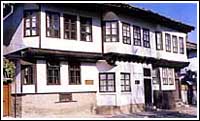 Devoted master-builders came both from Tryavna and the vicinal villages.
Houses, churches, schools, bridges and water fountains raised by them
were scattered not only far and away in Bulgaria but also in Wallachia,
Serbia, Turkey and Persia.
Devoted master-builders came both from Tryavna and the vicinal villages.
Houses, churches, schools, bridges and water fountains raised by them
were scattered not only far and away in Bulgaria but also in Wallachia,
Serbia, Turkey and Persia.
The names of master-builders Dimitur Sergyuv, Gencho Kunev, Gencho Novakov, Slav Tsanev, Rali Tsanev remain memorable for the inimitable constrictive and artistic quality of their buildings. Some of them make up complete museums in the open, such as the villages of Bozhentsi and Zheravna.
Very often master-builders were excellent wood-carvers, too. Treated with utmost respect among them were Dimitur Oshanetsa, Ivan Bouchoukovetsa, Papa Vitan Jr. and his son, priest Koyu Vitanov, Dimitur Doikovcheto, Gencho Marangozov, etc. In their skilful hands wood turned into winding vines, roses, sunflowers and tweeting birds.
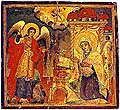 Equal in every way was the craftsmanship of Tryavna icon-painters, the
Vitanovs, Zaharievs, Minevs, Minchevs, priest Dimitur Kunchev and Venkovs
painted thousands of icons the fame of which travelled round over 500
settlements in Bulgaria. Austere or smiling, pensive or cheerful, the
icons of the Tryavna icon-painter conveyed the spirit of the time they
were created in through the years.
Equal in every way was the craftsmanship of Tryavna icon-painters, the
Vitanovs, Zaharievs, Minevs, Minchevs, priest Dimitur Kunchev and Venkovs
painted thousands of icons the fame of which travelled round over 500
settlements in Bulgaria. Austere or smiling, pensive or cheerful, the
icons of the Tryavna icon-painter conveyed the spirit of the time they
were created in through the years.
Click here to see larger picture
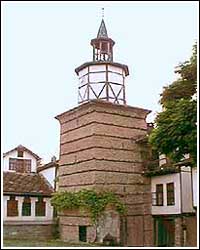 Tryavna has presented the only Renaissance set-piece square named
after Captain Dyado Nikola.
The Clock Tower erected in 1844 along with the Arch Bridge built 1844-45
by Dimitur Sergyuv have turned into the landmarks of the town.
Tryavna has presented the only Renaissance set-piece square named
after Captain Dyado Nikola.
The Clock Tower erected in 1844 along with the Arch Bridge built 1844-45
by Dimitur Sergyuv have turned into the landmarks of the town.
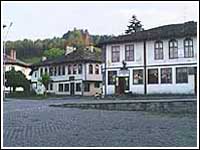
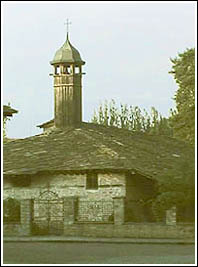 The oldest
building on the square is the church St. Archangel Michael being a
national monument of culture. After some kurdzhalii (Turkish mercenaries)
burnt it down in 1798, the church was rebuilt in 1819. The wonderful
wood-carved iconostasis was the handiwork of master wood-carvers from
Tryavna. The bishop's throne sculpted by priest Koyu Vitanov is a genuine
sample of the Tryavna wood-carving school. The church treasures the Tsar's
Crucifix, a relic handed down from generation to generation. It is made of
boxwood with 12 intricated tableaux on Gospel topics engraved on it.
The oldest
building on the square is the church St. Archangel Michael being a
national monument of culture. After some kurdzhalii (Turkish mercenaries)
burnt it down in 1798, the church was rebuilt in 1819. The wonderful
wood-carved iconostasis was the handiwork of master wood-carvers from
Tryavna. The bishop's throne sculpted by priest Koyu Vitanov is a genuine
sample of the Tryavna wood-carving school. The church treasures the Tsar's
Crucifix, a relic handed down from generation to generation. It is made of
boxwood with 12 intricated tableaux on Gospel topics engraved on it.